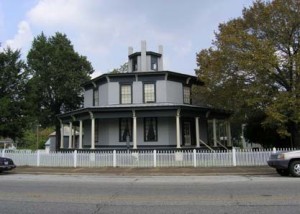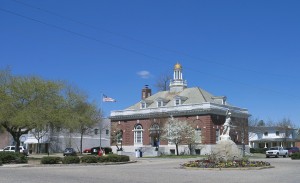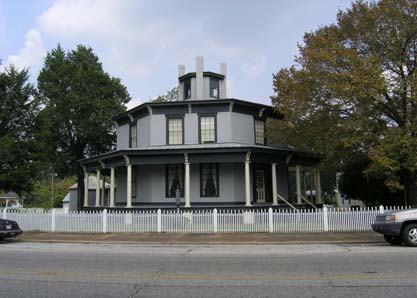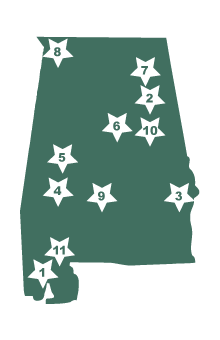The Barbour County Governors’ Trail was designated by legislative act in 2000 to recognize those from Barbour County who served as Alabama governors. These governors include John Gill Shorter (1861-1863), William Dorsey Jelks (1901-1907), Braxton Bragg Comer (1907-1911), Chauncey M. Sparks (1943-1947), George Corley Wallace (1963-1967, 1971-1979, and 1983-1987), and Lurleen B. Wallace (1967-1968). In addition, Jere Beasley and Charles McDowell also served short terms as acting governors.
The roadways designated as the Governors’ Trail are located within one of the most historic counties in Alabama; Barbour County (See Figure 1). From the early days of Alabama as a territory to the turbulent times of Governor George C. Wallace, Barbour County has been in the forefront of Alabama history and culture. As is mentioned above, Barbour County holds the unique distinction as home for eight of Alabama’s governors. As is discussed within the pages that follow, these governors were often not only in the Alabama spotlight, but the national spotlight as well. Governor Shorter was not only a strong secessionist and states rights advocate, but also a co-author of the confederate constitution. Governor George C. Wallace’s administration is still known by people of all ages for Governor Wallace’s stand at the entrance of the University of Alabama to uphold segregation. The other Barbour County governors played significant roles in issues such as the states education system, railroad regulation, the promotion of farm to market roads for Alabama’s farmers, and the writing of the Alabama constitution of 1901.
 In addition to the rich heritage related to former governors, the Governors’ Trail Scenic Byway also offers many other historic, scenic, and recreational resources. A traveler on the Governors’ Trial can visit the Octagon House where Union troops were headquarter during the reconstruction following the Civil War, or visit the site of the Old Franklin Road, the roadway settlers from Georgia used to reach Barbour County at the turn of the 19th century. In addition to the many historic sites along the Trail, travelers can also take advantage of recreational opportunities in the area such as Blue Springs State Park, and Lake Eufaula. Blue Springs State Park features a spring fed swimming pool, picnic and camping grounds as well as a playground. Blue Springs State Park is truly a camper’s paradise. Lake Eufaula offers boating, fishing and many other water related activities.
In addition to the rich heritage related to former governors, the Governors’ Trail Scenic Byway also offers many other historic, scenic, and recreational resources. A traveler on the Governors’ Trial can visit the Octagon House where Union troops were headquarter during the reconstruction following the Civil War, or visit the site of the Old Franklin Road, the roadway settlers from Georgia used to reach Barbour County at the turn of the 19th century. In addition to the many historic sites along the Trail, travelers can also take advantage of recreational opportunities in the area such as Blue Springs State Park, and Lake Eufaula. Blue Springs State Park features a spring fed swimming pool, picnic and camping grounds as well as a playground. Blue Springs State Park is truly a camper’s paradise. Lake Eufaula offers boating, fishing and many other water related activities.
The Governors’ Trail begins in Clio at the intersection of SR-10 and SR-51 and continues northeast through Louisville to downtown Clayton. The Trail then turns onto State Highway 30 and extends into Eufaula where it turns north at US Highway 431 ending at the Shorter Mansion. The total length of the Trail is approximately 36 miles.




